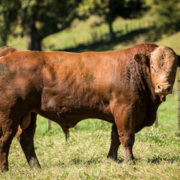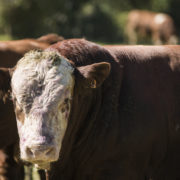Want To Wean 300kg Calves Instead Of 200kg Ones? Follow Our Five-Factor Formula To Grow Your Calves Heavier
With proven rapid growth rates and earlier finishing than other breeds – if weight gain is a key driver of your operation you simply can’t go past a Simmental.
Results of a Beef + Lamb NZ studied showed that with a first-cross Simmental, on average, you will see a 15 per cent increase in calf weaning weight per cow mated.
On a 200kg calf, that equates to a 30kg gain in live weight, which at $3.50/kg is $105 per calf at weaning. Multiplied across 50 calves, that gives you a total of $5,250. Not exactly spare change is it?
At Gold Creek we are passionate about supporting our clients to maximise the profitability of their commercial operations, so we’ve put together a five-factor formula for growing your calves heavier and faster.
FACTOR 1 – BULL SELECTION
With bull buying season upon us, our last blog looked at the topic of bull selection and the importance of Docility and Structure when it comes to selecting bulls – this should be the starting point and the foundation of all bull buying decisions.
That’s certainly not to say that EBV’s should be overlooked as these play a crucial role here as well. In our view, the three metrics you should pay most attention to in order to wean a thumping good calf are: Birth weight (BW), 200-day growth EBV and Milk EBV.
When using EBVs, It is important in any breeding programme to keep balance in mind as chasing single trait breeding can have a detrimental effect in the long term.
AI Verse Natural Mating (or a combo of the two)
FACTOR 2 – AI Vs NATURAL MATING (OR A COMBINATION OF THE TWO)
AI has many advantages and can be a cost-effective way to rapidly increase the genetic gain in your herd by accessing the best genetics from around the world. It can also help condense your calving, with 60% calved within the first week and approximately 90% within the first month.
A combination system of AI and natural mating can also work well: you may choose AI using a Hereford/Angus bull for your replacements and then use a terminal bull such as a
Simmental as your backup.
FACTOR 3 – NUTRITION
To get the best performance out of your cows (and achieve high weaning weights in your calves), you need to treat them right.
Feeding them well at certain times of the year is crucial and can be the difference between a condensed calving or a spread-out one, high pregnancy rates, or more calves weaned at 300kgs as opposed to 200kgs.
One good rule to follow is to separate male and female calves at a young age so that male calves can have priority feed.
FACTOR 4 – ANIMAL HEALTH
A drench one month prior to your calf weaner sale will help put a shiny gloss on your weaners’ coats and potentially clean out any internal parasites they might have picked up.
Mineral supplements are known to help with the immune system of young cattle and, more importantly, lactating cows, which can develop deficiencies through winter and calving during lactation. Addressing these deficiencies is not only necessary to maintain rapid growth in the calf, but also critical in ensuring the cow will get back in calf or end up dry (or late).
FACTOR 5 – HEIFER AND COW SELECTION
Heifer Selection
When it comes to your bulls and cows, you now know you can apply the basic selection pressures of structure and docility. In addition to this, there are new tools available to unlock the genetic potential of your herd.
Zoetis and Neogen both offer advanced and accurate DNA profiles for commercial breeders to take the guesswork out of your heifer selection, so you can guarantee you are selecting your genetically superior heifers every time and not unwittingly culling them.
COW SELECTION AND CULLING
Two questions to ask yourself: How are you culling your cows? What is your criteria?
As with most commercial beef farms, your basic but highly important criteria may include culling on account of dry, wet-dry or age. The next factors to consider would be feet, udder, docility and constitution.
These are all things you can see and are easily selected, but what about the unknowns? You can make some of the most rapid and significant gains by identifying which calves belong to which cows. By identifying your worst-performing cows every year and culling accordingly, you will rapidly increase your average weaning weight.
There are several ways to match the calves to cows, but the simplest and most accurate is to use DNA. A sample is taken from the calf’s ear at calf marking and sent away to the lab to be processed, which will then provide you with detailed results on the parentage of the calf.
Alternate, more cost-effective methods include tagging the calf at birth and recording which cow is its mother; or at calf marking. Leave the calves in overnight, then in the morning, let the calves in one by one to match with cows and record.
SUMMARY
By paying close attention to these five factors and implementing these tips into your farming operation, you can work towards putting an extra $350 in your pocket on each and every calf.
If these factors can add 100kg to calves at weaning (i.e. increasing weaning weight from 200kg to 300kg), you could expect an increase of $350 per calf at $3.50/kg.
If you’d like more information or want to talk to us more about how you can achieve these results, get in touch with us here.




